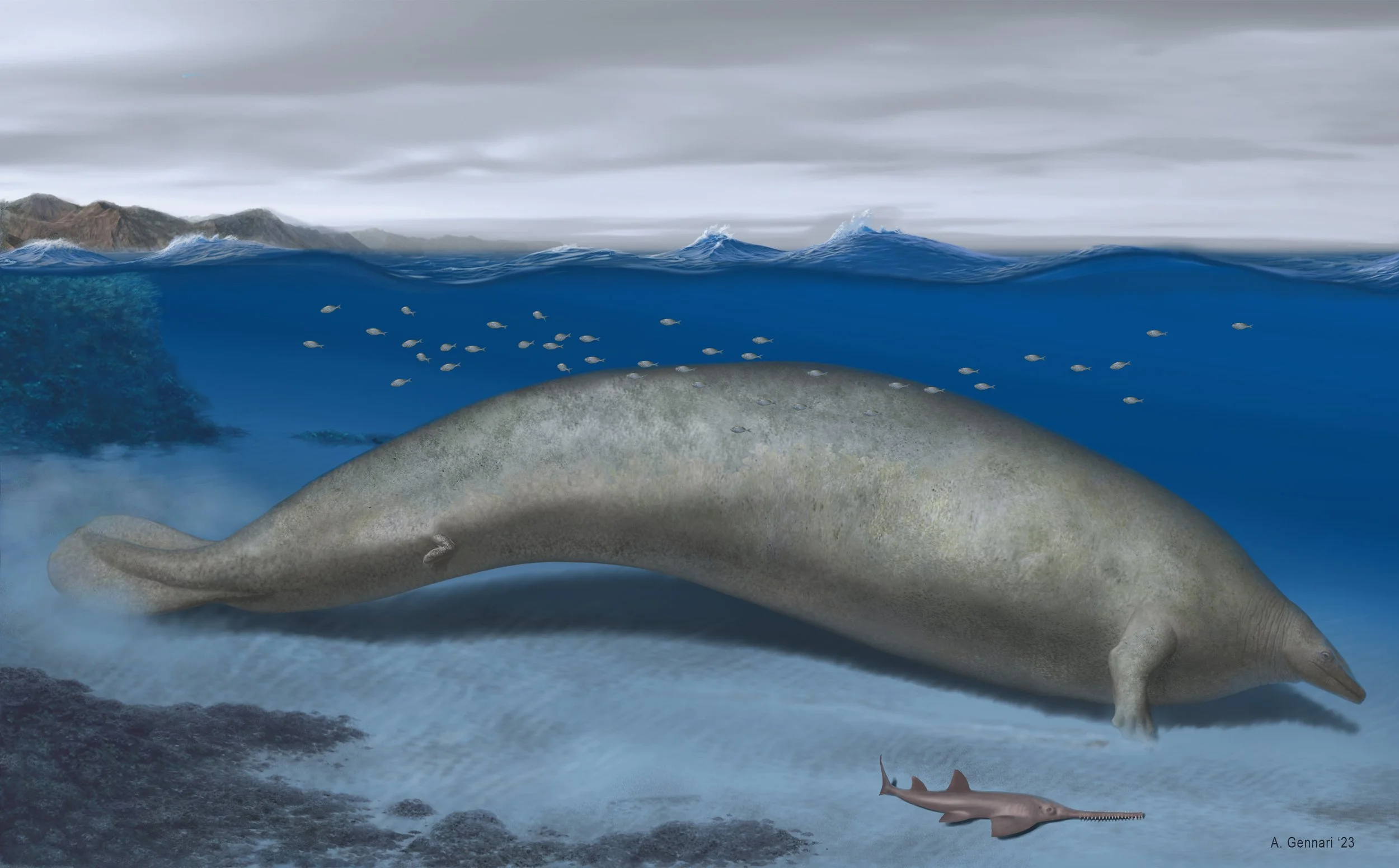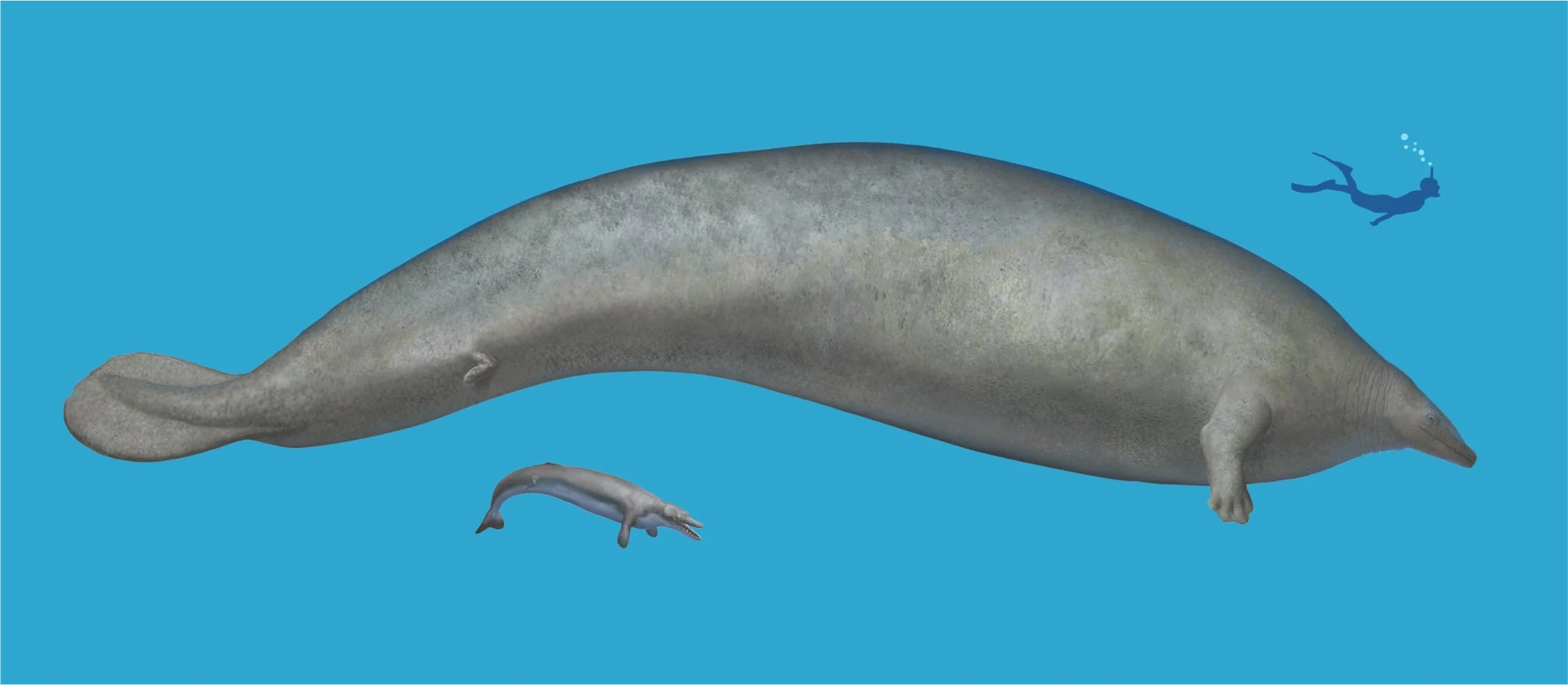New early whale is possibly the heaviest animal of all time
Researchers discovered the fossil of an extremely heavy prehistoric whale. The finding changes our understanding of whale evolution.
By State Museum of Natural History Stuttgart
An international team of scientists led by Dr. Eli Amson, paleontologist at the State Museum of Natural History Stuttgart, Germany, has discovered and studied the fossilized skeleton of a new species of early whale. This ancient relative of today's whales, dolphins and porpoises lived in coastal waters about 39 million years ago and had an enormous body mass. The new species is named Perucetus colossus, "the colossal whale from Peru". He is a contender for the title of "heaviest animal of all time". The research results of the team of scientists as well as the description of the new species Perucetus colossus, were published in the scientific journal Nature.
Reconstruction of Perucetus colossus in its coastal habitat. Estimated body length is about 20 metres. Credit: Alberto Gennari
The find brings new insights into the evolution of whales
The discovery of a truly giant species, such as Perucetus, which is affected by a sharp increase in bone mass, changes the understanding of whale evolution. Bone mass increase is an adaptation well known shallow diving, coastal animals. The researchers’ study shows that gigantic body masses were reached 30 million years earlier than previously thought.
Until now, the evolutionary transition to true gigantism in cetaceans, as seen in modern baleen whales (such as the blue whale), was considered a relatively recent event, occurring only about 10 million years ago. Furthermore, these gigantic species are offshore animals, unlike the newly described prehistoric whale.
"For us, one of the crucial findings of the work is that the transition to true gigantism in whales evolved much earlier in Earth's history than we previously thought. Perucetus colossus combines gigantic size with extremely high skeletal weight and lived 39 million years ago. This early whale drastically shifts the previously known upper limit of skeletal mass in mammals and aquatic vertebrates. It may also be the heaviest animal ever described," says Dr. Eli Amson of the State Museum of Natural History Stuttgart, Germany.
Reconstruction Perucetus and Supayacetus. Credit: Alberto Gennari
Adaptation to life in coastal waters
The fossils of whales and dolphins show how land animals can acquire extreme adaptations during their evolution and switch to life in water. Buoyancy becomes a crucial aspect of their biology.
"Already well known are the changes in bone mass in mammals that mostly live in shallow coastal waters, such as manatees. The extra weight helps these animals regulate their buoyancy and keep themselves underwater, much like a weight belt of divers. In contrast, in modern whales, which can dive to much greater depths and live far offshore, the bone structure is much lighter," says Dr. Eli Amson.
The enormous weight of Perucetus is due to two types of changes in the skeleton: The accumulation of extra bone mass on the outside of the skeletal elements and the increase in bone density, which makes the skeleton heavier.
Perucetus bone reconstruction. Credit: Eli Amson
A colossus estimated at 85 to 340 tons
Already 10 years ago, the fossils of Perucetus colossus were discovered in the desert on the southern coast of Peru by one of the authors, the paleontologist Mario Urbina. Subsequently, several field campaigns were necessary to unearth the parts of the colossal skeleton. Each vertebra weighs well over 100 kg and the ribs of the prehistoric whale reach a length of 1.4 metres. At five to eight tons, the 20-metre-long skeleton of the new species is two to three times heavier than the 25-metre-long skeleton of a blue whale on display in the Hintze Hall of the Natural History Museum in London.
To estimate the weight of Perucetus colossus during life, various analyses were carried out. The team of scientists first scanned the prepared bones to measure their volume and performed core drilling to assess the internal bone structure. Completely preserved skeletons of close relatives were also included in the analysis. To reconstruct the body mass of Perucetus, the authors finally used the ratio of soft tissue to skeletal mass known in living marine mammals.
With the resulting estimates between 85 and 340 tons, the weight of the new species is in the order of magnitude of the blue whale or possibly above.
Excavation Peru fossils Perucetus colossus. Credit: Giovanni Bianucci
A colossus estimated at 85 to 340 tons
Already 10 years ago, the fossils of Perucetus colossus were discovered in the desert on the southern coast of Peru by one of the authors, the paleontologist Mario Urbina. Subsequently, several field campaigns were necessary to unearth the parts of the colossal skeleton. Each vertebra weighs well over 100 kg and the ribs of the prehistoric whale reach a length of 1.4 metres. At five to eight tons, the 20-metre-long skeleton of the new species is two to three times heavier than the 25-metre-long skeleton of a blue whale on display in the Hintze Hall of the Natural History Museum in London.
To estimate the weight of Perucetus colossus during life, various analyses were carried out. The team of scientists first scanned the prepared bones to measure their volume and performed core drilling to assess the internal bone structure. Completely preserved skeletons of close relatives were also included in the analysis. To reconstruct the body mass of Perucetus, the authors finally used the ratio of soft tissue to skeletal mass known in living marine mammals.
With the resulting estimates between 85 and 340 tons, the weight of the new species is in the order of magnitude of the blue whale or possibly above.
Provided by State Museum of Natural History Stuttgart
Reference: Giovanni Bianucci, Olivier Lambert, Mario Urbina, Marco Merella, Alberto Collareta, Rebecca Bennion, Rodolfo Salas-Gismondi, Aldo Benites-Palomino, Klaas Post, Christian de Muizon, Giulia Bosio, Claudio Di Celma, Elisa Malinverno, Pietro Paolo Pierantoni, Igor Maria Villa, Eli Amson. A heavyweight early whale pushes the boundaries of vertebrate morphology. Nature (2023). DOI: https://doi.org/10.1038/s41586-023-06381-1





